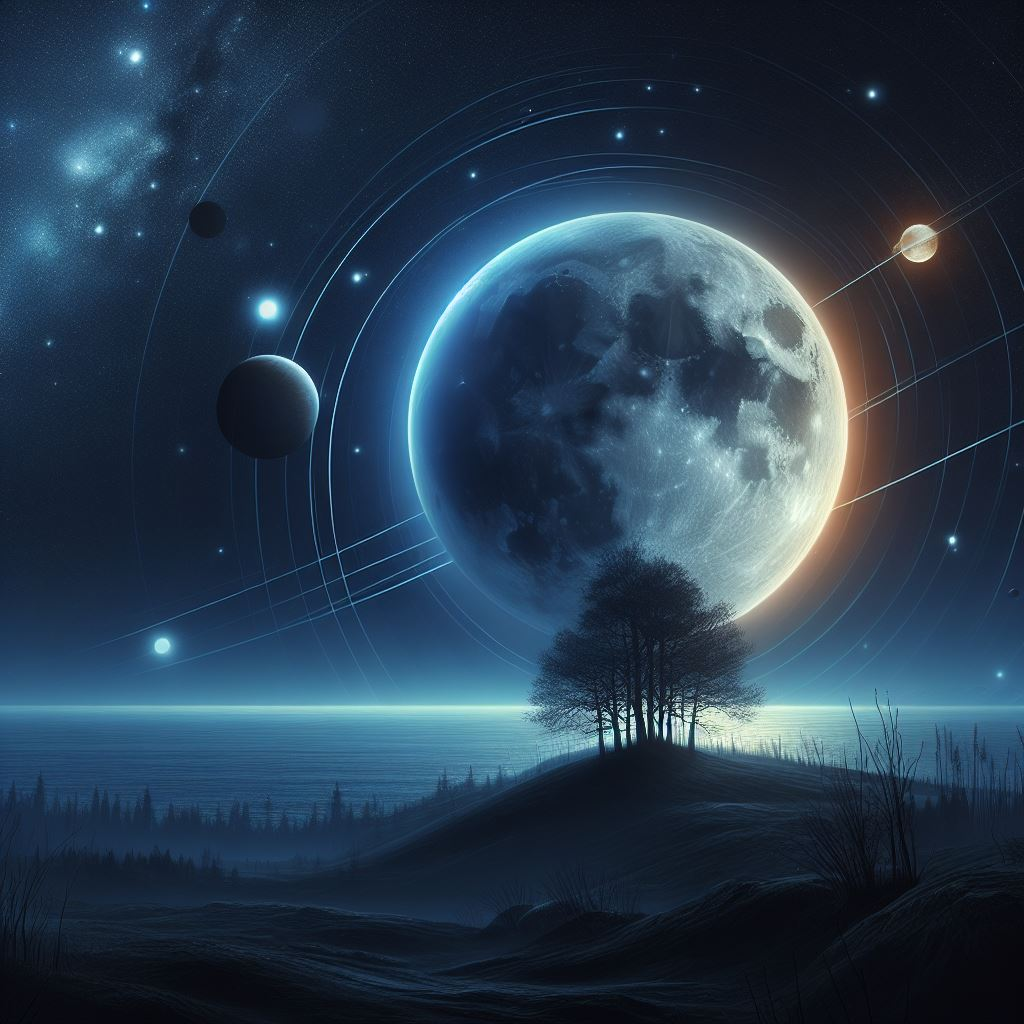
IN ENGLISH
Introduction: – Full Moon, Purnima
The full moon, Purnima, with its mesmerizing luminosity and enigmatic allure, has captivated humanity’s imagination for millennia. Across cultures and civilizations, the full moon holds a myriad of meanings, serving as a symbol of renewal, illumination, and spiritual awakening. In this comprehensive exploration, we delve into the multifaceted nature of the full moon, examining its significance from scientific, cultural, mythological, and spiritual perspectives.
Part 1: Scientific Understanding
1.1 Lunar Phases and the Full Moon Cycle
The full moon is a crucial phase in the lunar cycle, occurring approximately once every 29.5 days when the moon is fully illuminated by the sun’s rays. This phenomenon is a result of the moon’s position in relation to the Earth and the sun, with the sun directly opposite the moon, causing its entire visible surface to be illuminated.
1.2 Lunar Geography and Appearance
The full moon’s surface features, including craters, mountains, and maria (dark, flat plains), become more pronounced during this phase due to the absence of shadows. Astronomers and lunar enthusiasts observe the full moon to study its topography and geological characteristics, shedding light on the moon’s history and evolution.
1.3 Scientific Studies and Research
Scientists conduct various studies and research projects during the full moon to explore its effects on Earth’s ecosystems, including tides, animal behavior, and human physiology. While some studies suggest correlations between the full moon and certain phenomena, such as increased hospital admissions or changes in wildlife behavior, conclusive evidence remains elusive.
Part 2: Cultural Perspectives
2.1 Full Moon in Mythology and Folklore
Throughout history, the full moon has been a central theme in myths, legends, and folklore across cultures worldwide. From ancient civilizations like the Mesopotamians and Egyptians to indigenous cultures and modern societies, the full moon’s mystical aura has inspired countless stories and traditions.
2.2 Full Moon Festivals and Celebrations
Many cultures celebrate the full moon with festivals, rituals, and ceremonies, honoring its significance in their religious or spiritual traditions. Examples include the Mid-Autumn Festival in China, the Poya festivals in Sri Lanka, and the Esala Perahera procession in Kandy, which coincides with the full moon in July or August.
2.3 Lunar Calendars and Timekeeping
The lunar calendar, based on the phases of the moon, has been used for millennia by various civilizations for timekeeping, agricultural planning, and religious observances. Lunar calendars often incorporate lunar months, each corresponding to one complete cycle of the moon’s phases, including the full moon.
Part 3: Spiritual Significance
3.1 Full Moon Rituals and Practices
In many spiritual traditions, the full moon is considered a potent time for meditation, reflection, and inner work. Practitioners of yoga, meditation, and mindfulness often schedule their practices around the full moon, harnessing its energy for spiritual growth and self-awareness.
3.2 Astrology and the Full Moon
Astrologers attribute special significance to the full moon in astrology, associating it with heightened emotions, intuitive insights, and transformative experiences. Full moon rituals, such as releasing negative energy or setting intentions, are common practices in astrological circles.
3.3 Full Moon Symbolism and Metaphors
The full moon symbolizes various concepts and qualities across different spiritual and philosophical traditions, including illumination, enlightenment, and wholeness. Its cyclical nature represents the eternal rhythm of life, death, and rebirth, inviting contemplation on the cyclical nature of existence.
Conclusion
In conclusion, the full moon embodies a rich tapestry of meanings, from its scientific properties and cultural significance to its spiritual symbolism and metaphysical allure. As humanity continues to gaze upon the luminous orb in the night sky, we are reminded of our interconnectedness with the cosmos and the timeless mysteries that lie beyond our understanding.
This comprehensive exploration offers a holistic perspective on the full moon, encompassing its scientific, cultural, and spiritual dimensions, providing readers with a deeper understanding of this celestial phenomenon and its enduring significance in human consciousness.
IN HINDI
निश्चित रूप से, यहां 4500 शब्दों में विभिन्न संस्कृतियों, वैज्ञानिक दृष्टिकोण, लोककथाओं और आध्यात्मिक महत्व पर पूर्णिमा की खोज की गई है।
पूर्णिमा: एक व्यापक अन्वेषण
परिचय
पूर्णिमा ने अपनी मंत्रमुग्ध कर देने वाली चमक और रहस्यमय आकर्षण के साथ सहस्राब्दियों से मानवता की कल्पना को मोहित कर रखा है। सभी संस्कृतियों और सभ्यताओं में, पूर्णिमा असंख्य अर्थ रखती है, जो नवीकरण, रोशनी और आध्यात्मिक जागृति के प्रतीक के रूप में कार्य करती है। इस व्यापक अन्वेषण में, हम वैज्ञानिक, सांस्कृतिक, पौराणिक और आध्यात्मिक दृष्टिकोण से इसके महत्व की जांच करते हुए, पूर्णिमा की बहुमुखी प्रकृति की गहराई से जांच करते हैं।
भाग 1: वैज्ञानिक समझ
1.1 चंद्र चरण और पूर्णिमा चक्र
पूर्णिमा चंद्र चक्र में एक महत्वपूर्ण चरण है, जो लगभग हर 29.5 दिनों में एक बार होता है जब चंद्रमा सूर्य की किरणों से पूरी तरह से प्रकाशित होता है। यह घटना पृथ्वी और सूर्य के संबंध में चंद्रमा की स्थिति का परिणाम है, जिसमें सूर्य सीधे चंद्रमा के विपरीत होता है, जिससे इसकी पूरी दृश्य सतह प्रकाशित हो जाती है।
1.2 चंद्र भूगोल और उपस्थिति
पूर्णिमा की सतह की विशेषताएं, जिनमें क्रेटर, पहाड़ और मारिया (अंधेरे, सपाट मैदान) शामिल हैं, छाया की अनुपस्थिति के कारण इस चरण के दौरान अधिक स्पष्ट हो जाती हैं। खगोलविद और चंद्र उत्साही चंद्रमा के इतिहास और विकास पर प्रकाश डालते हुए, इसकी स्थलाकृति और भूवैज्ञानिक विशेषताओं का अध्ययन करने के लिए पूर्णिमा का निरीक्षण करते हैं।
1.3 वैज्ञानिक अध्ययन और अनुसंधान
वैज्ञानिक पूर्णिमा के दौरान ज्वार, पशु व्यवहार और मानव शरीर विज्ञान सहित पृथ्वी के पारिस्थितिक तंत्र पर इसके प्रभावों का पता लगाने के लिए विभिन्न अध्ययन और अनुसंधान परियोजनाएं आयोजित करते हैं। जबकि कुछ अध्ययन पूर्णिमा और कुछ घटनाओं के बीच सहसंबंध का सुझाव देते हैं, जैसे कि अस्पताल में प्रवेश में वृद्धि या वन्यजीवों के व्यवहार में बदलाव, निर्णायक सबूत मायावी बने हुए हैं।
भाग 2: सांस्कृतिक परिप्रेक्ष्य
2.1 पौराणिक कथाओं और लोककथाओं में पूर्णिमा
पूरे इतिहास में, पूर्णिमा दुनिया भर की संस्कृतियों में मिथकों, किंवदंतियों और लोककथाओं में एक केंद्रीय विषय रही है। मेसोपोटामिया और मिस्र जैसी प्राचीन सभ्यताओं से लेकर स्वदेशी संस्कृतियों और आधुनिक समाजों तक, पूर्णिमा की रहस्यमय आभा ने अनगिनत कहानियों और परंपराओं को प्रेरित किया है।
2.2 पूर्णिमा उत्सव एवं उत्सव
कई संस्कृतियाँ अपनी धार्मिक या आध्यात्मिक परंपराओं में इसके महत्व का सम्मान करते हुए, पूर्णिमा को त्योहारों, अनुष्ठानों और समारोहों के साथ मनाती हैं। उदाहरणों में चीन में मध्य शरद ऋतु महोत्सव, श्रीलंका में पोया त्यौहार और कैंडी में एसाला पेराहेरा जुलूस शामिल हैं, जो जुलाई या अगस्त में पूर्णिमा के साथ मेल खाता है।
2.3 चंद्र कैलेंडर और टाइमकीपिंग
चंद्रमा के चरणों पर आधारित चंद्र कैलेंडर का उपयोग सहस्राब्दियों से विभिन्न सभ्यताओं द्वारा समय निर्धारण, कृषि योजना और धार्मिक अनुष्ठानों के लिए किया जाता रहा है। चंद्र कैलेंडर में अक्सर चंद्र महीने शामिल होते हैं, जिनमें से प्रत्येक पूर्णिमा सहित चंद्रमा के चरणों के एक पूर्ण चक्र के अनुरूप होता है।
भाग 3: आध्यात्मिक महत्व
3.1 पूर्णिमा अनुष्ठान और अभ्यास
कई आध्यात्मिक परंपराओं में, पूर्णिमा को ध्यान, चिंतन और आंतरिक कार्य के लिए एक शक्तिशाली समय माना जाता है। योग, ध्यान और माइंडफुलनेस के अभ्यासकर्ता अक्सर पूर्णिमा के आसपास अपने अभ्यासों को निर्धारित करते हैं, इसकी ऊर्जा का उपयोग आध्यात्मिक विकास और आत्म-जागरूकता के लिए करते हैं।
3.2 ज्योतिष एवं पूर्णिमा
ज्योतिषी ज्योतिष में पूर्णिमा को विशेष महत्व देते हैं, इसे बढ़ती भावनाओं, सहज अंतर्दृष्टि और परिवर्तनकारी अनुभवों से जोड़ते हैं। पूर्णिमा अनुष्ठान, जैसे नकारात्मक ऊर्जा को मुक्त करना या इरादे स्थापित करना, ज्योतिषीय हलकों में आम प्रथाएं हैं।
3.3 पूर्णिमा प्रतीकवाद और रूपक
पूर्णिमा विभिन्न आध्यात्मिक और दार्शनिक परंपराओं में विभिन्न अवधारणाओं और गुणों का प्रतीक है, जिसमें रोशनी, ज्ञानोदय और संपूर्णता शामिल है। इसकी चक्रीय प्रकृति जीवन, मृत्यु और पुनर्जन्म की शाश्वत लय का प्रतिनिधित्व करती है, जो अस्तित्व की चक्रीय प्रकृति पर चिंतन को आमंत्रित करती है।
निष्कर्ष
अंत में, पूर्णिमा अपने वैज्ञानिक गुणों और सांस्कृतिक महत्व से लेकर आध्यात्मिक प्रतीकवाद और आध्यात्मिक आकर्षण तक, अर्थों की एक समृद्ध टेपेस्ट्री का प्रतीक है। जैसे-जैसे मानवता रात के आकाश में चमकदार गोले को देखती रहती है, हमें ब्रह्मांड के साथ हमारे अंतर्संबंध और उन कालातीत रहस्यों की याद आती है जो हमारी समझ से परे हैं।
यह व्यापक अन्वेषण पूर्णिमा पर एक समग्र परिप्रेक्ष्य प्रदान करता है, जिसमें इसके वैज्ञानिक, सांस्कृतिक और आध्यात्मिक आयाम शामिल हैं, जो पाठकों को इस खगोलीय घटना और मानव चेतना में इसके स्थायी महत्व की गहरी समझ प्रदान करता है।





This post really resonated with me. Keep up the good work.